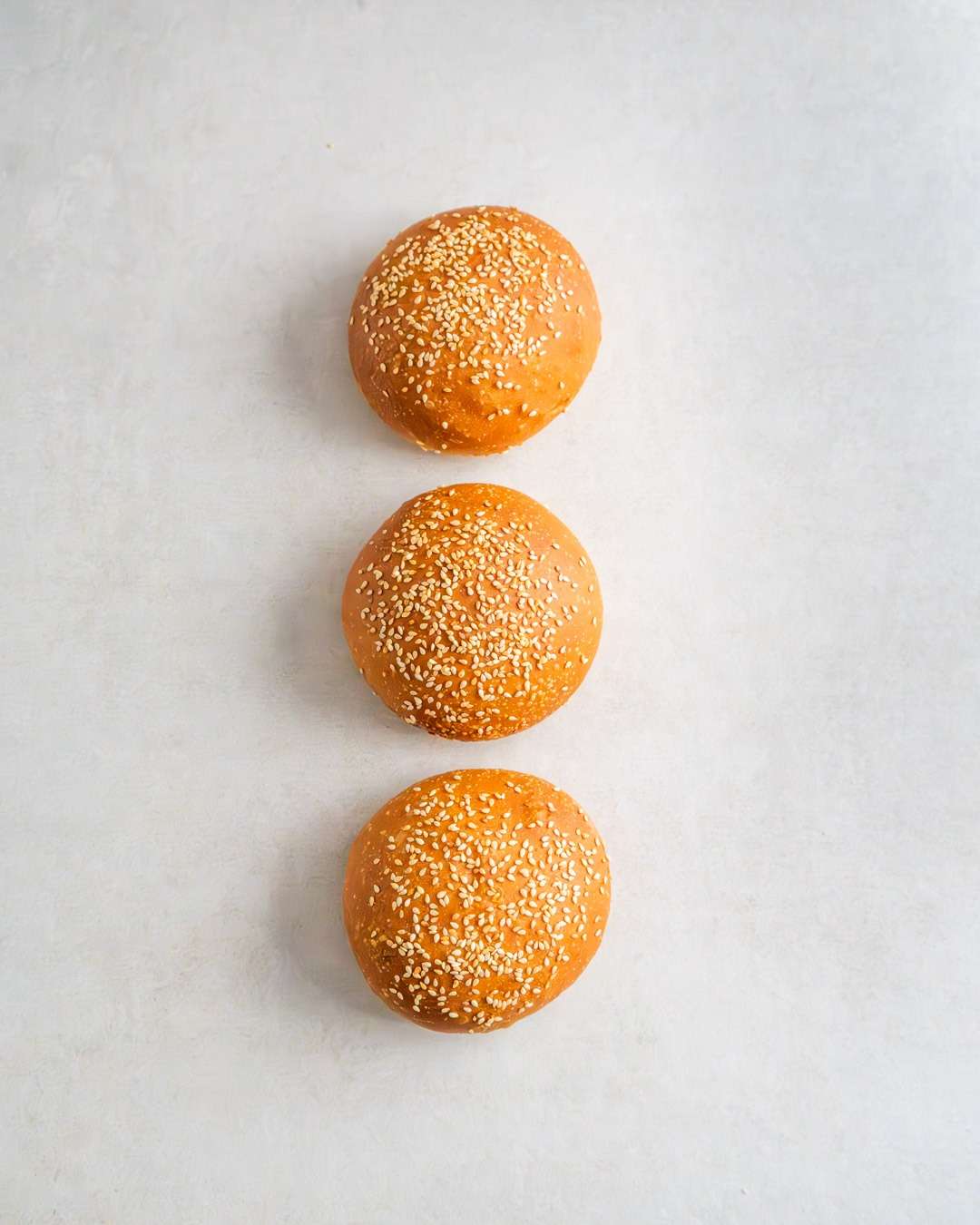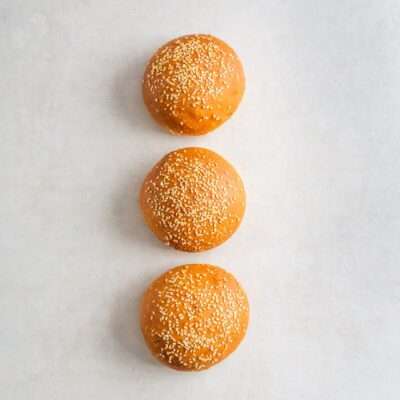Burger Buns

I rarely ‘veganise’ food. Whenever I crave anything, there’s usually a plant-based alternative hidden in the culinary treasures of this world. You want to veganise pasta? Why not just try the many eggless pasta dishes of the South of Italy, for instance Lolli con Fave? You want a creamy pudding. How about Puerto Rico’s Tembleque. Or instead of pudding, have Goma Dofu as a silky appetiser.
The same applies to stuffed food, where the wrapping, usually a form of bread, often already happens to be vegan from Gözleme to Tacos. Yet brioche buns are a different story. Sure, Vada Pav is essentially vegan and so is Pane e Panelle, but the buns they’re served in are usually not. And because I didn’t want to deprive myself of the pleasures of those culinary highlights, I set out to find a reliable recipe that would allow me to cook those traditionally plant-based dishes and pack them into a vegan burger bun.
This really is a simple go-to recipe that you can use whenever you need soft burger buns or fluffy bread rolls. It’s the exact method I used for the Vada Pav and the Cazzilli. I like experimenting with different flours whenever I make them. You can swap some of the bread flour for wholemeal flour and adjust the water ratio (wholemeal absorbs more water), or you can do the same with spelt, einkorn or a mix of those. They’re easy to make and the Slap & Fold method (explained below) is a useful technique to have up your sleeves for any kind of dough.
Storage
You ideally want to consume the buns the same day. If you have leftovers, keep them in an airtight container for 1-2 days. You can also freeze the baked buns and, when needed, simply thaw them for 1-2 hours at room temperature in an airtight container or bag.
serves 4 | makes 8 burger buns
Ingredients
-
20g fresh yeast (or 7g dried yeast)
-
1 tsp golden granulated sugar
-
50g olive oil (55 ml)
-
290 ml warm water
-
500g bread flour
-
10g salt
-
2 tbsp non-dairy milk
-
1 tbsp maple syrup
-
Sesame seeds
Method
Crumble the yeast into a medium-sized mixing bowl. Add the sugar, oil and water and stir with a fork to dissolve.
In a large bowl, whisk together the flour and salt, pour in the dissolved yeast and use your hands to mix everything into a rough dough. Tip out the dough onto a work surface and knead it until it becomes too sticky to handle. Then simply cover it with a bowl turned upside down and let it rest for 10 minutes. The flour will continue to absorb the water, which kickstarts the gluten development and makes it easier to handle.
After 10 minutes, it will still be too sticky to knead. Instead, we’re using a technique called Slap & Fold (watch here), which allows us to handle doughs with a higher hydration without adding more flour. That way our final buns will be extra soft. Start by lifting up the dough, then slapping one end of it back onto the work surface. Now fold the other end (the one you’re holding) over the dough, thereby stretching it slightly and developing the gluten structure. Turn the dough by 90° and repeat. Try to do this in confident and quick movements to avoid the dough from sticking to your hands. After a few turns, you will notice the dough beginning to firm up. You can now give it a knead until it becomes too sticky again, then simply repeat the Slap & Fold. Work the dough this way for around 10 minutes, until it feels soft & pliable and less sticky to the touch. Shape it into a large ball by stretching it with both hands curbed around it towards you over the surface. It should spring back when you poke it, otherwise knead it a little longer. Grease a large bowl with oil and transfer the dough. Then cover it with a damp kitchen towel or a reusable plastic bag and leave it to proof and double in size for around 1 hour.
Deflate the dough by punching it down a little bit, then divide it into 8 equal portions (roughly 100g – 110g each). Shape each piece of dough into a ball by stretching it over the surface in circular movements with one hand. You really want to stretch the dough here to create a smooth surface across it. Think of it as a skin that drapes around the rest of the dough and traps the air while proving and baking, which allows it to expand beautifully. Divide the finished balls over two lined baking tray to give them plenty of space between each other. Then cover again with the damp towel or even some moistened baking paper and let them double once more for 45-75 minutes. At this point, they should feel jiggly when you shake the tray and if you poke them firmly with a finger, they should only slowly spring back and not completely. Two signs, that your buns are ready to be baked.
In the meantime, pre-heat the oven to 200°C. Once the buns are ready, combine the non-dairy milk of your choice with the maple syrup and brush it over the buns. Sprinkle over the sesame seeds. Then bake them for 20-25 minutes until golden brown, turning the tray 180° halfway through for even baking. Let them cool down for 30 minutes to allow them to soften before serving.
Storage: Ideally, consume them the same day. Otherwise, keep in an airtight container for 1-2 days. You can also freeze them and, when needed, simply thaw them for 1-2 hours at room temperature in an airtight container or bag.

Burger Buns
Ingredients
- 20 g fresh yeast (or 7g dried yeast)
- 1 tsp golden granulated sugar
- 50 g olive oil (55 ml)
- 290 ml warm water
- 500 g bread flour
- 10 g salt
- 2 tbsp non-dairy milk
- 1 tbsp maple syrup
- Sesame seeds
Instructions
- Crumble the yeast into a medium-sized mixing bowl. Add the sugar, oil and water and stir with a fork to dissolve.
- In a large bowl, whisk together the flour and salt, pour in the dissolved yeast and use your hands to mix everything into a rough dough. Tip out the dough onto a work surface and knead it until it becomes too sticky to handle. Then simply cover it with a bowl turned upside down and let it rest for 10 minutes. The flour will continue to absorb the water, which kickstarts the gluten development and makes it easier to handle.
- After the 10 minutes, it will still be too sticky to knead. Instead we’re using a technique called Slap & Fold (watch here), which allows us to handle doughs with a higher hydration without adding more flour. That way our final buns will be extra soft. Start by lifting up the dough, then slapping one end of it back onto the work surface. Now fold the other end (the one you’re holding) over the dough, thereby stretching it slightly and developing the gluten structure. Turn the dough by 90° and repeat. Try to do this in confident and quick movements to avoid the dough from sticking to your hands. After a few turns, you will notice the dough beginning to firm up. You can now give it a knead until it becomes too sticky again, then simply repeat the Slap & Fold. Work the dough this way for around 10 minutes, until it feels soft & pliable and less sticky to the touch. Shape it into a large ball by stretching it with both hands curbed around it towards you over the surface. It should spring back when you poke it, otherwise knead it a little longer. Grease a large bowl with oil and transfer the dough. Then cover it with a damp kitchen towel or a reusable plastic bag and leave it to proof and double in size for around 1 hour.
- Deflate the dough by punching it down a little bit, then divide it into 8 equal portions (roughly 100g - 110g each). Shape each piece of dough into a ball by stretching it over the surface in circular movements with one hand. You really want to stretch the dough here to create a smooth surface across it. Think of it as a skin that drapes around the rest of the dough and traps the air while proving and baking, which allows it to expand beautifully. Divide the finished balls over two lined baking tray to give them plenty of space between each other. Then cover again with the damp towel or even some moistened baking paper and let them double once more for 45-75 minutes. At this point, they should feel jiggly when you shake the tray and if you poke them firmly with a finger, they should only slowly spring back and not completely. Two signs, that your buns are ready to be baked.
- In the meantime, pre-heat the oven to 200°C. Once the buns are ready, combine the non-dairy milk of your choice with the maple syrup and brush it over the buns. Sprinkle over the sesame seeds. Then bake them for 20-25 minutes until golden brown, turning the tray 180° halfway through for even baking. Let them cool down for 30 minutes to allow them to soften before serving.

Hi Julius, for all your recipes that require baking, do I need to reduce the recommended oven temperature by 20°C, since I have a fan-forced oven?
I have tried your Burger Buns and Chocolate Babka recipes, but I feel with the temperature stated in the recipe they became a bit dry and hard.
Yes, most recipes follow conventional oven settings, so if you have a fan-forced oven then please reduce by 20 🙂